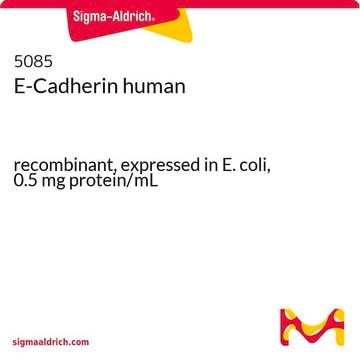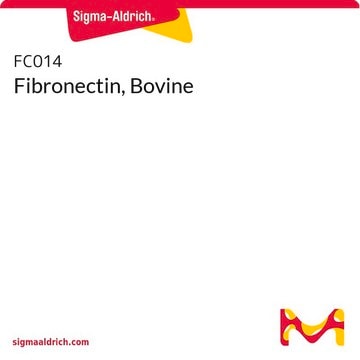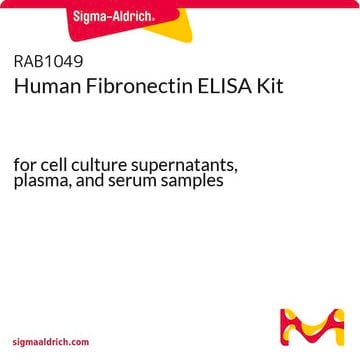ECM001
Human Fibronectin
recombinant, expressed in HEK 293 cells, powder, suitable for cell culture
Sinónimos:
Fibronectin, CIG, Cold-insoluble globulin, FN
About This Item
Productos recomendados
product name
Fibronectina, recombinant, expressed in HEK 293 cells, lyophilized powder, suitable for cell culture
biological source
human
Quality Level
recombinant
expressed in HEK 293 cells
sterility
sterile
assay
≥95% (SDS-PAGE)
form
lyophilized powder
mol wt
259.5 kDa (The protein migrates as a higher band on SDS-PAGE due to glycosylation.)
packaging
pkg of 200 μg
technique(s)
cell culture | mammalian: suitable
impurities
≤1 EU/μg endotoxin, tested
solubility
water: soluble
NCBI accession no.
UniProt accession no.
shipped in
ambient
storage temp.
−20°C
Gene Information
human ... FN1(2335)
¿Está buscando productos similares? Visita Guía de comparación de productos
General description
Application
Recommended for use as a cell culture substratum at 1-5 μg/cm2 or 0.5-50 μg/ml. Optimal concentration depends on cell type as well as the application or research objectives.
Biochem/physiol Actions
Features and Benefits
- Human-derived fibronectin
- Produced through recombinant expression in HEK 293 cells
- Low endotoxin levels
- Absence of bacterial contamination
Physical form
Analysis Note
Storage Class
11 - Combustible Solids
wgk_germany
WGK 3
flash_point_f
Not applicable
flash_point_c
Not applicable
Certificados de análisis (COA)
Busque Certificados de análisis (COA) introduciendo el número de lote del producto. Los números de lote se encuentran en la etiqueta del producto después de las palabras «Lot» o «Batch»
¿Ya tiene este producto?
Encuentre la documentación para los productos que ha comprado recientemente en la Biblioteca de documentos.
Los clientes también vieron
Artículos
The extracellular matrix (ECM) and its attachment factor components are discussed in this article in relation to their function in structural biology and their availability for in vitro applications.
The extracellular matrix (ECM) and its attachment factor components are discussed in this article in relation to their function in structural biology and their availability for in vitro applications.
The extracellular matrix (ECM) and its attachment factor components are discussed in this article in relation to their function in structural biology and their availability for in vitro applications.
The extracellular matrix (ECM) and its attachment factor components are discussed in this article in relation to their function in structural biology and their availability for in vitro applications.
Protocolos
Dilute fibronectin for cell attachment, varying per cell type. Coating protocol, products, and FAQs provided.
Nuestro equipo de científicos tiene experiencia en todas las áreas de investigación: Ciencias de la vida, Ciencia de los materiales, Síntesis química, Cromatografía, Analítica y muchas otras.
Póngase en contacto con el Servicio técnico









